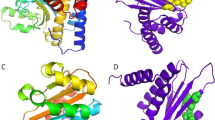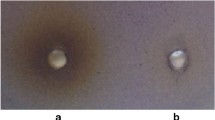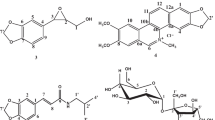Abstract
The present study was carried out to assess the anti-quorum sensing (anti-QS) activity of bark extract obtained from the mangrove plant Rhizophora annamalayana Kathir. against Gram-negative bacteria. In microtitre plate assay, the bark extract at a concentration of 1 mg/ml inhibited the QS-dependent violacein production in Chromobacterium violaceum ATCC 12472. Further, the QS-dependent bioluminescence production in the aquatic bacterial pathogen Vibrio harveyi MTCC 3438 was also reduced to the level of 99 % when treated with the same concentration of the extract. Gas chromatography–mass spectrum analysis identified the presence of seven different chemical constituents, 1H-purin-6-amine, cycloheptasiloxane, cyclooctasiloxane, cyclononasiloxane, cyclononasiloxane octadecamethyl, cyclodecasiloxane eicosamethyl and 1,1,1,5,7,7,7-heptamethyl-3,3-bis(trimethylsiloxy)tetrasiloxane. The molecular docking analysis of the identified compounds revealed that the compounds cyclononasiloxane octadecamethyl and cyclodecasiloxane eicosamethyl exhibited the best docking energy with the QS receptors of C. violaceum and V. harveyi with that of the natural ligand N -hexanoyl- l -homoserine lactone (C6-HSL) and furanosyl borate diester (AI-2). Similarly, another compound 1,1,1,5,7,7,7-heptamethyl-3,3-bis(trimethylsiloxy)tetrasiloxane showed best docking energy only against C6-HSL. Thus, the results of the present study divulge the activity of R. annamalayana bark extract to interfere with bacterial QS.





Similar content being viewed by others
References
Abeysinghe PD (2010) Antibacterial activity of some medicinal mangroves against antibiotic resistant pathogenic bacteria. Indian J Pharm Sci 72:167–172
Agoramoorthy G, Chandrasekaran M, Venkatesalu V, Hsu MJ (2007) Antibacterial and antifungal activities of fatty acid methyl esters of the blind-your-eye mangrove from India. Braz J Microbiol 38:739–742
Annapoorani A, Jabbar AKKA, Musthafa KS, Pandian SK, Ravi AV (2012) Inhibition of quorum sensing mediated virulence factors production in urinary pathogen Serratia marcescens PS1 by marine sponges. Indian J Microbiol 52:160–166
Bjarnsholt T, Givskov M (2007) Quorum sensing blockade as a strategy for enhancing host defences against bacterial pathogens. Phil Trans R Soc B 362:1213–1222
Bodini SF, Manfredini S, Epp M, Valentini S, Santori F (2009) Quorum sensing inhibition activity of garlic extract and p-coumaric acid. Lett Appl Microbiol 49:551–555
Brackman G, Defoirdt T, Miyamoto C, Bossier P, Calenbergh SV, Nelis H, Coenye T (2008) Cinnamaldehyde and cinnamaldehyde derivatives reduce virulence in Vibrio spp. by decreasing the DNA-binding activity of the quorum sensing response regulator LuxR. BMC Microbiol 8:149
Cha C, Gao P, Chen YC, Shaw PD, Farrand SK (1998) Production of acyl-homoserine lactone quorum sensing signals by gram-negative plant associated bacteria. Mol Plant Microbe Interact 11:1119–1129
Chandrasekaran M, Kannathasan K, Venkatesalu V, Prabhakar K (2009) Antibacterial activity of some salt marsh halophytes and mangrove plants against methicillin resistant Staphylococcus aureus. World J Microb Biotechnol 25:155–160
Chen X, Schauder S, Pelczer I, Bassler BL, Hughson FM, Potier N, Van Dorsselaer A (2002) Structural identification of a bacterial quorum sensing signal containing boron. Nature 415:545
Chen JD, Feng DQ, Yang ZW, Wang ZC, Qiu Y, Lin YM (2008) Antifouling metabolites from the mangrove plant Ceriops tagal. Molecules 13:212–219
Chen JD, Yi RZ, Lin YM, Feng DQ, Zhou HC, Wang ZC (2011) Characterization of terpenoids from the Root of Ceriops tagal with antifouling activity. Int J Mol Sci 12:6517–6528
Choo JH, Rukayadi Y, Hwang JK (2006) Inhibition of bacterial quorum sensing by vanilla extract. Lett Appl Microbiol 42:637–641
Defoirdt T, Boona N, Bossierb P, Verstraete W (2004) Disruption of bacterial quorum sensing: an unexplored strategy to fight infections in aquaculture. Aquaculture 240:69–88
Ding X, Yin B, Qian L, Zeng Z, Yang Z, Li H, Lu Y, Zhou S (2011) Screening for novel quorum-sensing inhibitors to interfere with the formation of Pseudomonas aeruginosa biofilm. J Med Microbiol 60:1827–1834
Dong YH, Xu JL, Li XZ, Zhang LH (2000) AiiA, an enzyme that inactivates the acylhomoserine lactone quorum-sensing signal and attenuates the virulence of Erwinia carotovora. Proc Natl Acad Sci 97:3526–3531
Dong YH, Wang LH, Zhang LH (2007) Quorum-quenching microbial infections: mechanisms and implications. Phil Trans R Soc B 362:1201–1211
Fuqua WC, Winans SC, Greenberg EP (1994) Quorum sensing in bacteria—the LuxR–LuxI family of cell density responsive transcriptional regulators. J Bacteriol 176:269–275
Geske GD, O’Neill JC, Blackwell HE (2007) N-Phenylacetanoyl-l-homoserine lactones can strongly antagonize or superagonize quorum sensing in Vibrio fischeri. ACS Chem Biol 22:315–319
Han L, Huang X, Sattler I, Moellmann U, Fu H, Lin W, Grabley S (2005) New aromatic compounds from the marine mangrove Bruguiera gymnorrhiza. Planta Med 71:160–164
Jeong K, Shin YC, Park S, Park JS, Kim N, Um JY, Go H, Sun S, Lee S, Park W, Choi Y, Song Y, Kim G, Jeon C, Park J, Lee K, Bang O, Ko SG (2011) Ethanol extract of Scutellaria baicalensis Georgi prevents oxidative damage and neuroinflammation and memorial impairments in artificial senescence mice. J Biomed Sci 18:14
Kadri A, Zarai Z, Békir A, Gharsallah N, Damak M, Gdoura R (2011) Chemical composition and antioxidant activity of Marrubium vulgare L. essential oil from Tunisia. Afr J Biotechnol 10:3908–3914
Kathiresan K (2000) A review of studies on Pichavaram mangrove, southeast India. Hydrobiologia 430:185–205
Kathiresan K, Bingham BL (2001) Biology of mangroves and mangrove ecosystem. Adv Mar Biol 40:81–251
Kathiresan K, Rajendran N (2002) Fishery resources and economic gain in three mangrove areas on the south east coast of India. Fishe Manag Ecol 9:277–283
Krishnamoorthy M, Sasikumar JM, Shamna R, Pandiarajan C, Sofia P, Nagarajan B (2011) Antioxidant activities of bark extract from mangroves Bruguiera cylindrica (L.) Blume and Ceriops decandra Perr. Indian J Pharmacol 43:557–562
Krishnan T, Yin WF, Chan KG (2012) Inhibition of quorum sensing controlled virulence factor production in Pseudomonas aeruginosa PAO1 by ayurveda spice clove (Syzygium Aromaticum) bud extract. Sensors 12:4016–4030
Kuenzer C, Bluemel A, Gebhardt S, Quoc TV, Dech S (2011) Remote sensing of mangrove ecosystems: a review. Remote Sens 3:878–928
Li M, Ni N, Chou HT, Lu CD, Tai PC, Wang B (2008) Structure based discovery and experimental verification of novel AI-2 quorum sensing inhibitors against Vibrio harveyi. Chem Med Chem 3:1242–1249
Manefield M, De Nys R, Kumar N, Read R, Givskov M, Steinberg P, Kjelleberg S (1999) Evidence that halogenated furanones from Delisea pulchra inhibit acylated homoserine lactone (AHL)-mediated gene expression by displacing the AHL signal from its receptor protein. Microbiology 145:283–291
Manefield M, Harris L, Rice SA, de Nys R, Kjelleberg S (2000) Inhibition of luminescence and virulence in the black tiger prawn (Penaeus monodon) pathogen Vibrio harveyi by intercellular signal antagonists. Appl Environ Microbiol 66:2079–2084
Manefield M, Rasmussen TB, Henzter M, Andersen JB, Steinberg P, Kjelleberg S, Givskov M (2002) Halogenated furanones inhibit quorum sensing through accelerated LuxR turnover. Microbiology 148:1119–1127
McLean RJ, Pierson LS, Fuqua C (2004) A simple screening protocol for the identification of quorum signal antagonists. J Microbiol Methods 58:351–360
Musthafa KS, Ravi AV, Annapoorani A, Packiavathy ISV, Pandian SK (2010) Evaluation of antiquorum sensing activity of edible plants and fruits through inhibition of the N-acyl homoserine lactone system in Chromobacterium violaceum and Pseudomonas aeruginosa. Chemotherapy 56:333–339
Packiavathy ISV, Agilandeswari P, Musthafa KS, Pandian SK, Ravi AV (2012) Antibiofilm and quorum sensing inhibitory potential of Cuminum cyminum and its secondary metabolite methyl eugenol against Gram-negative bacterial pathogens. Food Res Int 45:85–92
Pesci EC, Pearson JP, Seed PC, Iglewski BH (1997) Regulation of las and rhl quorum sensing in Pseudomonas aeruginosa. J Bacteriol 179:3127–3132
Ponnusamy K, Paul D, Kim YS, Kweon JH (2010) 2(5H)-furanone: a prospective strategy for biofouling-control in membrane biofilm bacteria by quorum sensing inhibition. Braz J Microbiol 41:227–234
Qian PY, Dobretsov S, Dahms H, Pawlik J (2006) Antifouling activity and microbial diversity of two congeneric sponges Callyspongia spp. from Hong Kong and the Bahamas. Mar Ecol Prog Ser 324:151–165
Rasmussen TB, Givskov M (2006) Quorum sensing inhibitors: a bargain of effects. Microbiology 152:895–904
Skindersoe ME, Ettinger-Epstein P, Rasmussen TB, Bjarnsholt T, de Nys R, Givskov M (2008) Quorum sensing antagonism from marine organisms. Mar Biotechnol 10:56–63
Sundaram R, Ganesan R, Murugesan G (2012) In vitro antiplasmodial activity of spiro benzofuran compound from mangrove plant of Southern India. Asian Pac J Trop Med 5:358–361
Swift S, Lynch MJ, Fish L, Kirke DF, Tomas JM, Stewart GSAB, Williams P (1999) Quorum sensing-dependent regulation and blockade of exoprotease production in Aeromonas hydrophila. Infect Immun 67:5192–5199
Williams P, Winzer K, Chan WC, Camara M (2007) Look who’s talking: communication and quorum sensing in the bacterial world. Phil Trans R Soc B 362:1119–1134
Yang L, Rybtke MT, Jakobsen TH, Hentzer M, Bjarnsholt T, Givskov M, Nielsen TT (2009) Computer aided identification of recognized drugs as Pseudomonas aeruginosa quorum sensing inhibitors. Antimicrob Agents Chemother 53:2432–2443
Zarai Z, Kadri A, Chobba IB, Mansour RB, Bekir A, Mejdoub H, Gharsallah N (2011) The in vitro evaluation of antibacterial, antifungal and cytotoxic properties of Marrubium vulgare L. essential oil grown in Tunisia. Lipids Health Dis 10:161
Zhang LL, Lin YM, Zhou HC, Wei SD, Chen JH (2010) Condensed tannins from mangrove species Kandelia candel and Rhizophora mangle and their antioxidant activity. Molecules 15:420–431
Zhu H, Sun SJ (2008) Inhibition of bacterial quorum sensing-regulated behaviors by Tremella fuciformis extract. Curr Microbiol 57:418–422
Acknowledgments
The authors are thankful to the authorities of Annamalai University for providing the necessary facilities. One of the authors, K. Syed Musthafa is very grateful to University Grants Commission (UGC), Government of India, for the financial support in the form of ‘UGC-Dr. D.S. Kothari Post Doctoral Fellowship’ [F.4-2/2006 (BSR)/13-612/2012(BSR)]. The authors also thank Dr. R. Babu Rajendran, Associate Professor, Department of Environmental Biotechnology, Bharathidasan University, for his help in providing GC–MS facility.
Author information
Authors and Affiliations
Corresponding author
Rights and permissions
About this article
Cite this article
Musthafa, K.S., Sahu, S.K., Ravi, A.V. et al. Anti-quorum sensing potential of the mangrove Rhizophora annamalayana . World J Microbiol Biotechnol 29, 1851–1858 (2013). https://doi.org/10.1007/s11274-013-1347-8
Received:
Accepted:
Published:
Issue Date:
DOI: https://doi.org/10.1007/s11274-013-1347-8




